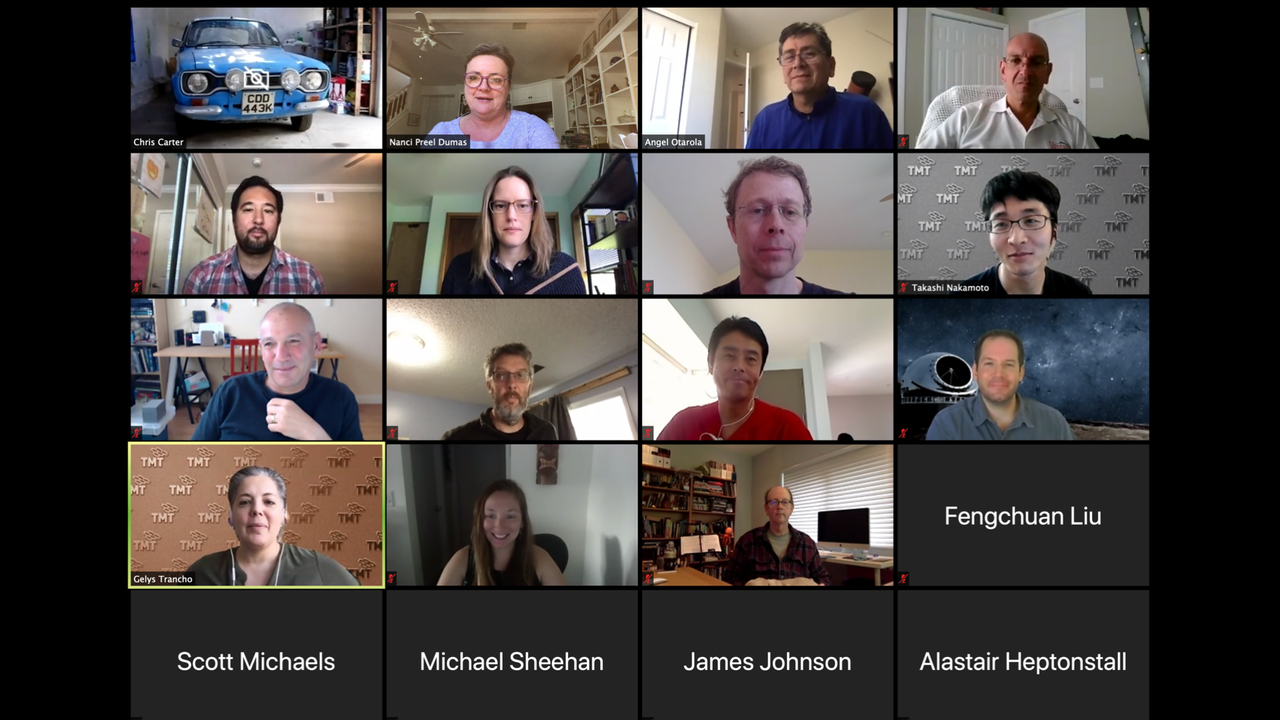
Screenshot of the participants in the TMT Engineering Sensors Preliminary Design Review - A group of approximately 20 engineers attended the review held remotely on 5 May 2020 - Image credit: TMT International Observatory


Screenshot of the participants in the TMT Engineering Sensors Preliminary Design Review - A group of approximately 20 engineers attended the review held remotely on 5 May 2020 - Image credit: TMT International Observatory
Pasadena, CA – Recently, the TMT Engineering Sensors System (ESEN) successfully passed its Preliminary Design Review (PDR) and is now ready to enter the Final Design phase. Chris Carter and Scott Michaels, TMT telescope control and software engineers, led a team of four people in presenting the design to the review panel.
ESEN is a unique, distributed system and its purpose is to automatically gather environmental and engineering data from sensors of various types at many different locations around the telescope structure and the enclosure. ESEN will process, transmit, store and make available the resulting data that will support the commissioning, engineering, troubleshooting and long-term performance monitoring of the facility. The data will be used by operations staff, engineers and scientists throughout the lifetime of the facility.
Carter said: “ESEN will provide critical insight into parameters such as local vibrations, the temperature distributions of the air and structural components, and the wind speeds inside the dome, which greatly influence how the telescope performs. ESEN’s data will help us understand, model and track the effects of variant conditions over the operational lifetime of the telescope. It’s really quite an important system.”
ESEN’s design team took advantage of developments in industrial automation technology that have significantly advanced the performance and lowered the cost of sensor and control systems. The preliminary design, approved by the review panel, is based upon distributed industrial controllers developed by Beckhoff GmbH. ESEN will use the high-speed network protocol EtherCAT and a real-time PLC-based control system based on TwinCAT 3 to gather data from more than 100 different sensors, some separated by hundreds of meters, in different parts of the facility.
A slide from the ESEN PDR presentation showing the types, locations and numbers of sensors that ESEN will initially support - About 120 sensors of 10 different types will be mounted on the telescope structure and enclosure - Image credit: TMT International Observatory.
“It is critical that we deliver a system that meets its design requirements and stays within its budget,” added Carter. “The adoption of a proven industrial technology that is commercially successful and widely used - even by other telescope projects for various purposes - was a significant factor in our choice. We have been able to use it to develop a flexible and expandable system design that is well placed to meet TMT’s needs in the near and long term.”
Software
Once ESEN has gathered data from its sensors, it needs to be made available for analysis as well as for storage in an “engineering archive”. Scott Michaels, who developed the ESEN software architecture, summed up his work: “The ESEN software extends the capabilities of the Beckhoff controllers. A machine called the “ESEN Core”, or “Core”, collects and publishes the data gathered by the Beckhoff hardware. Core is responsible for controlling the entire ESEN system and publishing the sensor data to TMT's clients and the data archive. To properly do this requires that the ESEN software be designed to fit in, and make full use of TMT software infrastructure.”
A dedicated team
Kayla Hardie and Josh Church are members of the ESEN team with essential systems engineering and mechanical design skills. Their work was instrumental to the success of the PDR. ESEN is involved in several other systems (e.g., the secondary and tertiary mirror systems), and the work done by the systems engineering team was critical to secure clear and properly documented interfaces between all of them. This work required careful tracking of connection between systems, as well as the meticulous production of mechanical drawings and three-dimentional computer-aided-design models showing the ESEN hardware location on the telescope and enclosure. This work will allow other TMT design teams to understand the impact the ESEN hardware may have on their own systems.
An excerpt from a Mechanical Interface Control Document showing where sonic anemometers (wind speed sensors) will be located on the telescope structure - The telescope-mounted sensors and sensor stations are identified in the Space Envelope drawings - . Image credit: TMT International Observatory.
Final Design and after…
With the Preliminary Design now complete, the architecture choices made for ESEN provide solid grounds to refine its software and hardware during a Final Design Phase. There is still plenty of prototyping, testing and design to be done and, following its Final Design Review, ESEN will be built, tested, shipped to and integrated with the telescope. Then, for more than 50 years of operations, it will provide round-the-clock data to help TMT making transformational discoveries about the nature of our Universe.
For more information on Beckhoff GmbH, you may click https://www.beckhoff.com .
TMT Instrumentation Cryogenic Cooling System Moves on to the Final Design Phase
Conceptual Design of TMT’s Wide-Field Optical Spectrometer Instrument Progresses